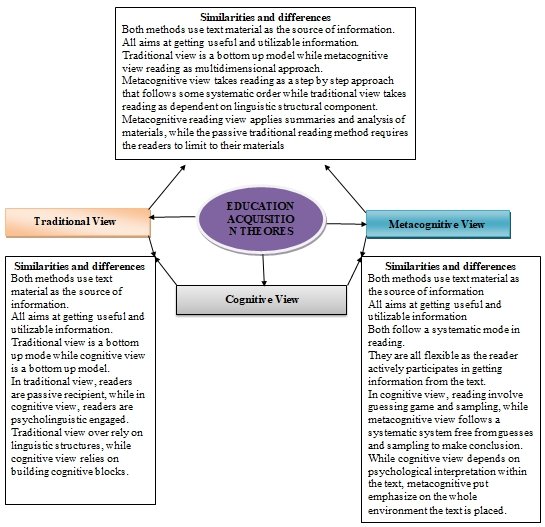There are three main reading views namely: traditional, cognitive and metacognitive reading views. The views shares some similarities and differences, this is because cognitive and metacognitive views are developed theories from traditional reading view. The shifts have resulted from changes in scientifically research developments and growing different uses of read information. As a result, several changes have occurred in the reading views to meet the changes trends in information use (TE, 2006).
Despite the shifts, the reading views share several similarities to date. However, traditional reading theory bears little similarities to metacognitive and cognitive respectively. Likewise cognitive and metacognitive views, tradition reading method aims at getting information that can be purposefully be utilized.
All the three modes of reading depend on reading texts to get the required information. However, unlike cognitive and metacognitive modes, traditional reading view solely depends on linguistic structure of a text. Consequently, traditional reading theory was blamed on failure to give the required information due to its overreliance on linguistic structure. The bottom up system was changed with the top up cognitive view. The diagram below shows relations of the Reading Acquisition Theories (Elizabeth & Donald, 2010).

Cognitive view is closely associated to metacognitive reading method. In this model, the reader builds cognitive blocks from the text based on psychological guesses, developing hypothesis and rejecting them to come to conclusion. Schema theory has been identified as sample of cognitive reading.
Cognitive reading is flexible reading style as the reader can interpret the text from his psychological construction. However unlike cognitive reading, metacognitive reading involves analyzing the text systemically. The reader is allowed to look beyond the text while analyzing the plot. Summaries are then drawn on the text to make final conclusion (Elizabeth & Donald, 2010).
References
Elizabeth, A., & Donald J. (2010). The New Literacies: Multiple Perspectives on Research and Practice. New York: Guilford Press.
TE, E. (2006). Teaching English. Theories of Reading. Web.